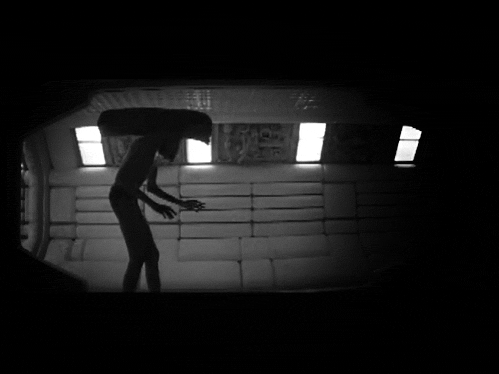
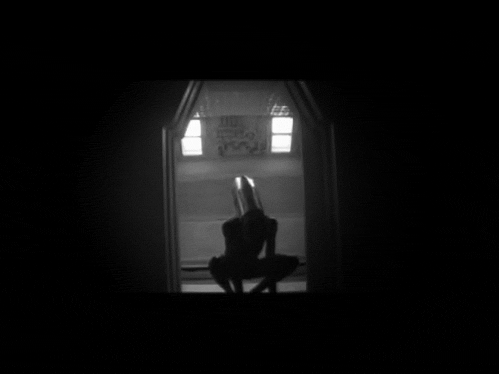
Alien / Xenomorph movement practice (1978-9)
Leandro Gabrielbonita(?) homenagem de aniversário.

If there was one Wu-Tang member who was consistently at the wrong place at the right time, the wrong guy for the right moment, it was U-GOD (Lamont Jody Hawkins, AKA Golden Arms, born 1970). Though a founding member of the Clan, because he spent eight months of 1992 in jail for a controlled substance charge, U-God was reduced to little more than a few background vocals and an intro on Enter the Wu-Tang (36 Chambers), and his career never recovered. Unable to get a record deal like the other members, his record Golden Arms Redemption belatedly came out on RZA’s label (but with somewhat equivocal help from RZA) in 1999, and was only modestly successful at avoiding being labeled a failure. Jazz-Rap had petered out a few years before, so the most successful tracks, the terrific Marvin Gaye-sampling Bizarre and the much underplayed Soul Dazzle, failed to get anyone very excited and — more crucially — failed to convince anyone that U-God’s smooth baritone was a natural match for funk. Even 2009′s surprisingly great Wu-Tang succeeds largely by rubbing some funk (and some Method Man) on it. His ongoing beef with RZA over royalties that repeatedly rises up at the least opportune times has done little to give voice to his perpetually muffled brilliance.
***
ALSO ON HILOBROW: RZA | Ghostface Killah | Ol’ Dirty Bastard
On his or her birthday, HiLobrow irregularly pays tribute to one of our high-, low-, no-, or hilobrow heroes. Also born this date: Hans Magnus Enzensberger and Carlos Fuentes.
READ MORE about members of the Reconstructionist Generation (1964–73).
Leandro GabrielNÃO COMECEM.
 NOVOS RICOS
NOVOS RICOS
O iraniano Mahbod Moghadam, de 29 anos, um dos fundadores do Rap Genius, site de letras de música que recebeu investimento de US$ 15 milhões, afirma que sonha revolucionar a navegação na web.
ÉPOCA – No começo de outubro, vocês receberam o investimento de US$ 15 milhões. O que farão com esse dinheiro?
Mahbod Moghadam – Estamos contratando muito mais desenvolvedores e também pessoas que possam gerenciar as comunidades de rock clássico, indie rock, leis, poesia, a Bíblia e outros textos religiosos. Também estamos explorando o Medical Genius, que servirá para trocar informações sobre saúde. Antes de tudo, virá o aplicativo do Rap Genius para smartphones. Sairá muito, muito rápido.
ÉPOCA – Como você ficou amigo de Tom Lehman e Ilan Zechory, os dois co-fundadores do site?
Moghadam – Todos nós estudávamos na Universidade de Yale, em Nova York. Também tínhamos nossos próprios blogs, o que nos aproximou em certo momento.
ÉPOCA – Como surgiu a ideia para criar o site?
Moghadam – Nós três odiávamos nossos trabalhos. Fui demitido do meu emprego num escritório de advocacia, e Tom, que é programador, criou Rap Genius para mim. Tem sido uma boa terapia.
ÉPOCA – O site então surgiu porque você estava deprimido?
Moghadam – Sim. Eu estava obcecado, ansioso. Estava me sentindo como se tivesse gastado toda minha vida na escola de direito. Agora estamos começando o Law Genius também. Servirá para explicar leis para muita gente.
ÉPOCA – Como vocês pretendem expandir para outras áreas? Mudarão de nome para cada segmento?
Moghadam – Somente Jesus sabe responder. Quero que haja sites separados. A área médica será um desafio porque não tenho, até o momento, ninguém para contratar. Mas tenho contatos nas áreas de lei, de poesia e de rock. Então, naturalmente, estou mais empolgado com esses três. Ah, e estamos buscando alguém para música country! Também tem o Rap Genius Brazil, que deu uma parada. Precisamos de mais parceiros.
ÉPOCA – O site de medição online ComScore diz que vocês tem, por mês, uma média de 2 milhões de visitantes únicos. Vocês têm alguma meta de crescimento?
Moghadam – Será o maior site do mundo em um ano — guarde minhas palavras! — se nós chegarmos ao patamar da atual comunidade de rap com as de rock, poesia, Bíblia e leis. Acho que isso pode mudar o conhecimento humano.
ÉPOCA – Depois do investimento milionário e dos holofotes em cima do Rap Genius, sua vida mudou muito? Considera-se realizado?
Moghadam – Talvez no papel (risos). Eu dirijo um Audi... Tem sido uma boa terapia. O dinheiro serve só para o champanhe.
Leandro Gabriel“When I was down perhaps six or seven feet, surrounded only by the damp brown walls of old Mother Earth, I was seized by an undeniable fancy to keep on going.”
In September 1924, the wheels of a truck sank into the ground behind the Pelham Courts apartments in Washington, D.C. On investigating, the building’s manager and janitor discovered a mysterious brick-lined passageway that led to a bizarre network of concrete tunnels extending as much as 32 feet underground.
The discovery put Washington into two days of wild speculation. Was this a German plot? A relic of the Civil War? But then Smithsonian Institution entomologist Harrison G. Dyar came forward to admit that he had dug the tunnels when had lived in the capital 10 years earlier. From Modern Mechanix, August 1932:

Dyar’s obsession had begun innocently enough. He told the Washington Star that in 1906 he had dug a flowerbed for his wife, and “When I was down perhaps six or seven feet, surrounded only by the damp brown walls of old Mother Earth, I was seized by an undeniable fancy to keep on going.” He had continued the project in secret for 10 years, stopping only in 1915, when he moved out of the area.
“I did it for exercise,” he told the New York Times. “Digging tunnels after work is my hobby. There’s really nothing mysterious about it.”
(Thanks, Allyson.)
If you’ve ever been to Venice, you’ll remember that it’s a chock-a-block city. Not just with with tourists but with houses, shops, palazzos and basilicas that seem to pile on top of each other, squeezed into every nook and cranny. In Venice and most of it’s surrounding islands of the lagoon, there is no more room at the inn.
So how could it be that one island, in between Venice and Lido, sits entirely uninhabited, abandoned and “not visitable” according to guide books?
Images via RansomGiggs.comThe last people that tried to inhabit Poveglia, a family, gained access the island to build a vacation home there. They didn’t last through the first night when their daughter’s face was split open ‘by something’ and was later treated with 20 stitches.
Today many locals avoid Poveglia like the plague, just as they did in the 16th century when the island was literally plagued. In 1576, the black death hit Venice and corpses began piling up on the streets, poisoning the air. Being the kind souls they were, authorities decided to take drastic measures and haul the dead to Poveglia and dump them into mass graves, just as the Romans had done before them when they rounded up thousands of plague victims centuries earlier, and dumped them in the very same spot.
As the plague became more devastating, even the living suspected of carrying symptoms, along with young children were dragged from their homes and left to die in terror on Poveglia. It is estimated 160,000 people were disposed of on the island.
It might be worth noting at this point that the term quarantine was in fact coined in Venice. The word comes from quaranta giorni (forty days), the duration travelers were once required to stay on an isolated island or boat before they could be issued a clean bill of health and enter the mainland or continue on their travels.
Fast-forward to the early 20th century and the quarantine island’s soil is still littered with human bones and ash. And in typical style of psychiatric asylums to choose the creepiest locations available, one sets up shop right on Poveglia in 1922.
Almost immediately, patients began reporting that hey had seen ghosts of plague victims and hearing menacing whispers echoing from the walls. As can be expected, the patients who were already deemed mad, continued to be treated as such.
The hospital was run by a doctor who experimented on his own patients, trying to make a name for himself and find the cause of their madness. He performed neurosurgical operations with basic hand drills, hammers and chisels. Folklore claims that he tortured and butchered his patients in the bell tower, whose ruins can still be seen from a distance, transcending the thick and twisted overgrowth.
But after several years, the doctor himself began claiming to have seen ghosts of the plague victims and one fateful day took his own life when he threw himself off the bell tower. The story goes that ghosts led him to the bell tower. According to the nurse who found him still alive at the base of the tower, he was finally choked by an ashy mist that swirled up from the ground and took his life. Locals say his remains were bricked up in that bell tower and on a still night, its tolls can be heard from across the lagoon.
The hospital was finally closed down in the 1960s. Scaffolding surrounds the old asylum not to preserve the decaying structure but simply to delay its collapse. The few potential buyers who have considered inhabiting the islands since the hospital’s closure, have stayed very, very briefly.
Poveglia has never been excavated to uncover the 16th century mass graves, nor the Roman ones that linger beneath. It is believed the most overgrown part of the island where an old vineyard once grew, is where the pits are most likely to be found.

Mass grave found on a neighboring island
On another nearby small island, Lazaretto Vecchio, workers digging the foundations for a new museum discovered a mass grave, filled with the remains of over 1,500 victims of the Black Death.
While technically Poveglia is forbidden to locals and the 3 million tourists that visit the region each year, a few explorers have made the journey. The island is lightly guarded by Venetian authorities but the harder part will be finding someone to get you there.
Convincing a boat operator to escort you to Poveglia can take several days and asking water taxis on the grand canal will be a guaranteed waste of time (and they’ll laugh in your face). One young film-maker/ photographer/ journalist Ransom Riggs however, managed to convince an old fishing boat-turned tour guide of the lagoons, Il Bragozzo, to do him the honor. The day trip wasn’t cheap but it’s thanks to him and the captain of Il Bragozzo that I’ve been able to share with you all these rare photographs of Poveglia.
Rigg’s account of his visit to the island is considerably less gruesome than those of the some of the previous visitors and compares it to “exploring the ruins of Mayan temples” rather than being in a horror movie. Maybe he went on a good day?! You can read about his fascinating visit here.
As for the dark folklore that riddles Poveglia’s past, is it just me or do they make this abandoned place even more appealing to visit?!
Happy Halloween countdown, readers!
:::
YOU MIGHT ALSO LIKE:
Leandro Gabriel"The Himalayan honey bee, Apis dorsata laboriosa, is the world’s largest, and its nests, which are only found at altitudes between 2,500 and 3,000 metres, can apparently contain as much as 60 kilograms of honey."
woo--
A new post on BLDGBLOG shows Eric Valli’s incredible photographs of men hunting for edible bird’s nests in the caves of Thailand, using a terrifyingly flimsy-looking assemblage of bamboo trellises, rattan ladders, and industrial nylon rope.

IMAGE: From the series “Shadow Hunters,” by Eric Valli.
In passing, the post mentions some of Valli’s other work, including a photo story documenting the “vertiginous and mind-bending world of ‘honey hunters‘ in the Himalayas.” This series, first published in National Geographic in 1988, won the World Press Photo Award for Nature Stories that year and remains awe-inspiring today.
In the shots, we see elderly Gurung tribesmen descending rope ladders hung over cliff faces in the Himalayan foothills, carrying long bamboo poles both for balance and to dislodge the hives, which are then lowered to the ground using a pulley system. The Himalayan honey bee, Apis dorsata laboriosa, is the world’s largest, and its nests, which are only found at altitudes between 2,500 and 3,000 metres, can apparently contain as much as 60 kilograms of honey.
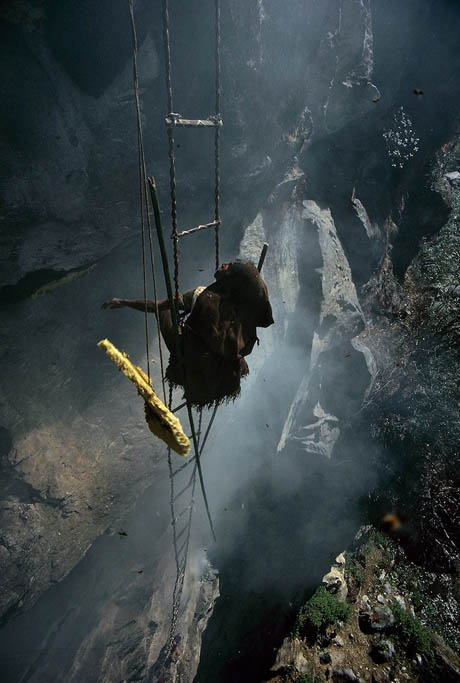
IMAGE: From the series “Honey Hunters of Nepal,” by Eric Valli.
The harvest is carried out twice a year, with the spring, or “red,” honey being especially valuable for its medicinal qualities, which are derived from grayanotoxin, a chemical produced by the rhododendrons on whose nectar the bees dine. But, according to another National Geographic article on the Himalayan honey bee, this one from 2004, red honey’s “relaxing properties” are currently threatening the bee’s very survival.

IMAGE: From the series “Honey Hunters of Nepal,” by Eric Valli.
Highly sought after by middle-aged men as a sexual performance enhancer, the red honey (also known as “mad honey”) reportedly fetched as much as $15 per kilo in 2004, which inspired the Nepali government to transfer “ownership of the cliffs from indigenous communities to the government and open up honey harvesting rights to contractors on a first-come, first-served basis,” according to Farooq Ahmad, coordinator of the Himalayan Honeybees project for the International Center for Integrated Mountain Development (ICIMOD) in Kathmandu, Nepal.
As a result, traditional honey hunting techniques and rituals that ensured a sustainable harvest and maintained bee populations have given way to non-traditional techniques that denude cliffs of nests in an effort by contractors to maximize profits.
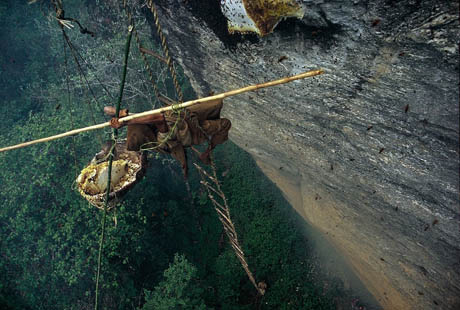
IMAGE: From the series “Honey Hunters of Nepal,” by Eric Valli.
Nonetheless, Ahmad is hopeful that honey hunting eco-tourism can help save the bees, which, according to National Geographic, are the prime pollinator for the entire Himalyan region, by rewarding the use of traditional, sustainable techniques with overseas dollars, and thus inspiring both a government policy reversal and an influx of young Gurung apprentices that will help keep the Himalayan honey hunters’ particular skills and knowledge alive.
For more of Valli’s photographs of extreme hunting infrastructure, visit his website, as well as BLDGBLOG’s post on the subject.
Leandro GabrielNÃO, CARA, PARA COM ISSO.
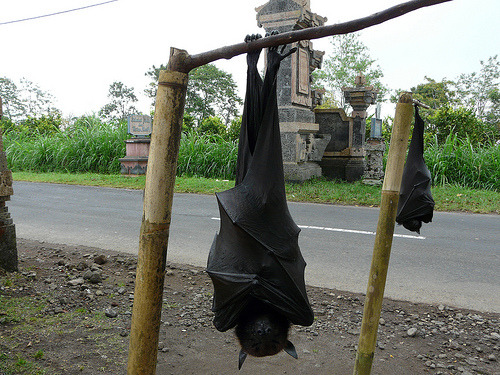

The giant golden-crowned flying fox (Acerodon jubatus), also known as the golden-capped fruit bat, is a rare megabat and one of the largest bats in the world. The species is endangered and is currently facing the possibility of extinction because of poaching and forest destruction. It is endemic to forests in the Philippines.
Leandro GabrielPARKOUR






“This is parkour. Internet sensation of 2004. And it was in one of the Bond films. It’s pretty impressive. The goal is to get from point A to point B as creatively as possible so technically they are doing parkour, as long as point A is delusion and point B is the hospital.”
 a gente acha ruim e olha no relógio e calcula o atraso e meia hora uma hora uma hora e meia, nem se pode esperar pontualidade de tipo que atrasa sempre e porque a gente gosta a gente releva, aprende a não se prender a horário e acreditar que vinte e uma e trinta é mera indicação de que o combinado acontecerá à noite. olha no relógio e suspira e arruma outra coisa para fazer etc. observar que sair de casa ele leva meia hora no banho meia hora para vestir o tênis ou encontrar uma camiseta ou pentear os cabelos e também os amigos fazem graça e querem saber como pode viver assim, como pode atrasar sempre, como pode não ficar brava. mas é que sim, meia hora para vestir as meias amarrar os cadarços arrumar os cabelos e perceber que tudo é um ato de amor por mais estúpido mais pequeno mais insignificante: sentar-se na cama para vestir as calças porque toda aquela altura e tem medo de se desequilibrar mas antes também vestir as meias tão vagarosamente e interromper-se por algo a dizer sobre uma letra de música ou um livro ou distraído e um comentário afetuoso e quem vai se importar com a ordem dos fatores se afinal, etc. apoiar o braço no joelho para amarrar o relógio e todas as ações que tão bem calculadas e o intervalo entre elas por necessidade de se olhar em volta e recalcular os passos e a todo momento recalculando os passos o próximo passo: que não haja no mundo nada pronto, nenhum procedimento definitivo e todas as ações repetidas são por reinventá-las no momento em que se fazem necessárias. e há ali algo de belo, de fazer sorrir porque a tranquilidade de se estar a cada minuto no lugar que se deve estar, jamais o desespero de estar em lugar outro, sem a pressa de adiantar o que só pode ser feito depois; estar inteiro no ato de amarrar o relógio no pulso e dar o nó nos cadarços do tênis, no ato de trancar o portão da frente depois de sair com o carro e conversar um pouco com o cachorro antes de se dirigir ao portão lateral, voltar-se para o cachorro e lhe dizer mais outras palavras e vê: é isso, essa plenitude do estar que desconsidera essa convenção esquisita a marcação do tempo e o mundo segue adiante inconsequente, os minutos correm, e quem se importa, de que nos interessa nos deixar ser arrastados pela ditatura do breve, do amanhã, da eficiência mecanizada de acordar pela manhã exatos dezessete minutos antes de sair para trabalhar vestir em dois minutos a roupa separada antes de dormir e escolher no metrô o vagão mais próximo da saída na estação em que deve descer.
a gente acha ruim e olha no relógio e calcula o atraso e meia hora uma hora uma hora e meia, nem se pode esperar pontualidade de tipo que atrasa sempre e porque a gente gosta a gente releva, aprende a não se prender a horário e acreditar que vinte e uma e trinta é mera indicação de que o combinado acontecerá à noite. olha no relógio e suspira e arruma outra coisa para fazer etc. observar que sair de casa ele leva meia hora no banho meia hora para vestir o tênis ou encontrar uma camiseta ou pentear os cabelos e também os amigos fazem graça e querem saber como pode viver assim, como pode atrasar sempre, como pode não ficar brava. mas é que sim, meia hora para vestir as meias amarrar os cadarços arrumar os cabelos e perceber que tudo é um ato de amor por mais estúpido mais pequeno mais insignificante: sentar-se na cama para vestir as calças porque toda aquela altura e tem medo de se desequilibrar mas antes também vestir as meias tão vagarosamente e interromper-se por algo a dizer sobre uma letra de música ou um livro ou distraído e um comentário afetuoso e quem vai se importar com a ordem dos fatores se afinal, etc. apoiar o braço no joelho para amarrar o relógio e todas as ações que tão bem calculadas e o intervalo entre elas por necessidade de se olhar em volta e recalcular os passos e a todo momento recalculando os passos o próximo passo: que não haja no mundo nada pronto, nenhum procedimento definitivo e todas as ações repetidas são por reinventá-las no momento em que se fazem necessárias. e há ali algo de belo, de fazer sorrir porque a tranquilidade de se estar a cada minuto no lugar que se deve estar, jamais o desespero de estar em lugar outro, sem a pressa de adiantar o que só pode ser feito depois; estar inteiro no ato de amarrar o relógio no pulso e dar o nó nos cadarços do tênis, no ato de trancar o portão da frente depois de sair com o carro e conversar um pouco com o cachorro antes de se dirigir ao portão lateral, voltar-se para o cachorro e lhe dizer mais outras palavras e vê: é isso, essa plenitude do estar que desconsidera essa convenção esquisita a marcação do tempo e o mundo segue adiante inconsequente, os minutos correm, e quem se importa, de que nos interessa nos deixar ser arrastados pela ditatura do breve, do amanhã, da eficiência mecanizada de acordar pela manhã exatos dezessete minutos antes de sair para trabalhar vestir em dois minutos a roupa separada antes de dormir e escolher no metrô o vagão mais próximo da saída na estação em que deve descer.
Two grand masters of irreverence come together.
In the early 1990s, two titans of the artfully cynical and subversive joined forces in an extraordinary collaboration: Legendary cartoonist and album cover artist R. Crumb illustrated two short books by Charles Bukowski, Bring Me Your Love (public library) and There’s No Business (public library). Crumb’s signature underground comix aesthetic and Bukowski’s commentary on contemporary culture and the human condition by way of his familiar tropes — sex, alcohol, the drudgery of work — coalesce into the kind of fit that makes you wonder why it hadn’t happened sooner.
In 1998, a final posthumous collaboration was released under the title The Captain Is Out to Lunch and the Sailors Have Taken Over the Ship (public library) — an illustrated selection from Buk’s previously unpublished diaries, capturing a year in his life shortly before his death in 1994.
 Brain Pickings has a free weekly newsletter and people say it’s cool. It comes out on Sundays and offers the week’s best articles. Here’s what to expect. Like? Sign up.
Brain Pickings has a free weekly newsletter and people say it’s cool. It comes out on Sundays and offers the week’s best articles. Here’s what to expect. Like? Sign up.
Brain Pickings takes 450+ hours a month to curate and edit across the different platforms, and remains banner-free. If it brings you any joy and inspiration, please consider a modest donation – it lets me know I'm doing something right.

Submitted by: Unknown (via 22 Words)
Tagged: kickass kid , shortest attention span ever , whiffle ball bat Share on Facebook